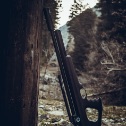Knowing the effective hunting range of any given airgun has been one of the most asked questions in the airgun world. It goes without saying that airguns are a great tool for small game hunting and pesting. With modern big bore airguns, this question becomes even more relevant. So how do you know your max hunting range? Let’s get into it.
For small game and pesting, it’s all down to accuracy, not equipment. Where the accuracy of the related airgun is part of the equation, it’s mostly the skill of the shooter at the trigger that’s really important.
If you want to find the max range for your airgun, then follow these steps.
#1: Train Like You Shoot in the Field
Step one is to sight in and practice in the same conditions and in the same way you will when hunting. If you hunt in a blind and use a bench or fully supported rest, then by all means, practice that way. But if you stalk and take your hunting shots without a rest, shooting sticks, or other aid, then that’s how you need to practice.
Let’s say, for argument’s sake, that you use shooting sticks when you are out hunting small game. Take a box and draw a quarter-sized circle on the box. Back up to 10 yards and take your shots. If you can put five shots in the circle, you pass. Now back up to 15 yards and try again. Are you still putting all your shots in the circle? That’s great! Now back up to 20 yards and keep testing until you start to miss.
Once you start missing the circle, you’ve found your limit. Most shooters hit their limit much closer than when they shoot from the bench. But now you know your limit with your airgun setup. If you want to be effective at greater ranges, then put in the time practicing with your hunting gear until you can put all five shots into the circle.
#2: Adjust Your Killzone
Hunting predators and larger game have some of the same aspects with a few more critical things to consider. You still need to be accurate with your gear, and you’ll want to test your max range in the same way.
You should adjust the kill zone to reflect the game you’ll be hunting. So let’s say you are hunting hogs. You can make the circle three inches instead of just one inch. If you are hunting deer, then you may go with an even larger circle. Do your research and learn your game so that you can know that you’ll be taking an ethical shot.
Beyond raw accuracy, you also need to consider the projectile’s flight time and retained energy at the target. A great example is when hunting with one of the new arrow shooters. You may be accurate to 50 yards, and with a broadhead, you’ll have plenty of killing power. But there’s a good chance that your target will jump at the sound of the shot, and best case, you’ll miss. Worst case, you’ll wound your game and not be able to recover it.
Traditional big-bore slug airguns have the same issues, specifically the larger caliber airguns shooting really heavy slugs. The energy will be there for deer, but you’ll need to consider some other variables when shooting hogs. Hogs can have a very thick shield that protects their vitals.
A suggested rule of thumb is the two to one rule regarding energy.
If you are hunting one hundred pound hogs, then you should bring an airgun that generates two hundred foot-pounds at the muzzle. This is not an absolute but rather a general way of estimating what you’ll need in the field. And then there’s flight time.
#3: Understand Flight Time & Range
It’s tough to know precisely how far you can take an ethical shot, but here are some simple guidelines that may help. Let’s concede that the accuracy and energy are there for whatever range you’ll be shooting, with 100 yards being our max range. It all comes down to velocity now.
How long does it take a projectile traveling 600 FPS to get to 50 yards? It takes over .25 of a second, not taking into consideration drag, elevation, atmospheric conditions, and other factors. It’s just a rough estimate. One-quarter of a second may not seem like a lot of time, but we’ve seen game move three to four inches before a slug impact at only 35 yards. Now stretch that out to 100 yards, and the real flight time may be more like .6 or .7 of a second. That’s an eternity in a hunting situation.
So, if you are shooting 700 FPS and under, keep your shots under 50 yards. As you get closer to 900 FPS, then you can stretch things out to 100 yards. The faster the projectile, the sooner it will get to the target and keep pace with the sound from your rifle’s report. Again, these are just quick guidelines to help you be a better, more successful airgun hunter.
In the end, it’s up to you to know your gear, your skill level, and your game. The more time you put into training and practicing in the same way that you hunt, the more successful you’ll be in the field. We hope these basic guidelines help you to be a better airgun hunter, and if you have more questions, then reach out to us here at Aigun Depot. We are always here to help.
